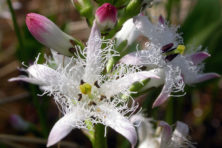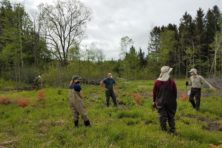Door To Nature: Wetlands Connect Wildlife
- Share
- Tweet
- Pin
- Share

We are fortunate in Door County to have numerous protected wetlands where so many vital members of the wildlife community live and interact. The Ridges Sanctuary in Baileys Harbor is a prime example.
It is so important to maintain clean unpolluted waters for the great numbers of plants, reptiles, amphibians, birds, fish, crustaceans and insects that live in them or find their food there.
Some of you may remember the great swarms of mayflies that appear for a few days in spring near large bodies of water. Lake Winnebago is one area where people think of them as a nuisance while they coat their homes and roads. I’ve also seen a large emergence of them on Kangaroo Lake one year.
This phenomenon is an annual occurrence during their mating season. It is well-established that an abundance of mayflies means that the nearby water is clean and healthy. They cannot survive in polluted lakes. These insects are an important source of food for other insects, spiders, fish and birds.
Roy Lukes, my late husband, was so interested in learning all the species of dragonflies in Door County and worked hard to photograph them. Most of these magnificent flyers need clean water to breed and dine on other insects. In fact, one item of food is the larvae of mosquitoes. Hooray for the dragonflies!
When the days become much warmer and it is sunny, you can walk on a few of the bridges way back in the northern swales at The Ridges Sanctuary and find a partly submerged log with western painted turtles basking in the sun.
These creatures spend the winter in the soft, oozy muck of the bottoms of the swales at near freezing temperatures. The turtles come up to “thaw out” on the sunny log waiting for the water temperature to reach the low 60s before they can resume active feeding.
It is estimated that about 60% of their food is animal, such as snails, small fish and crayfish, and 40% is aquatic plant material. These fascinating reptiles, whose ancestors lived with the dinosaurs, appear like statues on the sun-drenched log. But, if you get too close, they quickly dive into the water, heading for a safer place.

The wide-leaved cattail that calls many waterways home is a nesting site for red-winged blackbirds in much of the Midwest and yellow-headed blackbirds along the south end of Green Bay and in Horicon Marsh. The long, up to 8-foot stalks and leaves become nesting material for muskrat and beaver lodges and the massive starchy roots are eaten by geese and muskrats. Other birds that use the cattails are the least bittern and black-crowned night-heron.
The huge underwater biomass of an extensive cattail marsh can do a marvelous job of filtering and cleaning up the water. It helps immeasurably to improve the purity of the underground water that is found around the region and used by people living there.
Reptiles and amphibians such as the leopard frog, American toad, red-backed and blue-spotted salamanders and the northern water snake require clean water for food sources. They eat spiders which live near and on the water, small fish and crustaceans.
Clean water is where so many frogs and toads must lay eggs and then have the tadpoles grow. Roy and I were leading a tour of the Jackson Harbor Wildlife Preserve on Washington Island in June 2000. Lake Michigan levels were quite low then and we found hundreds of toad tadpoles in the shallow waters along the sandy shore.
So many bird species use our waterways to seek food, to nest, or to migrate through. Many small fish and amphibians are eaten by the nesting birds. Some sandpipers and snipes eat crayfish which can be found along the shallow shorelines.
Roy photographed a crayfish burrow at Toft Point one year and told me that is where the nymph stage, referred to as naiad (NY-ad), of the endangered Hines emerald dragonfly will spend three to five years. The dragonfly eggs are laid in wet sand, mud or wet moss at the water’s edge. The long time that naiads spend in these wet environments means they need clean water.
When I moved to Door County in 1972 there were no sandhill cranes here. The fact that they require clean wetlands to find food and build nests means it is vital that we not drain prime wetlands. Marshes, bogs, open edges of swamps and even flooded lowland fields are sought by these birds.

Waste grain remaining in fields are where we see these stately tall birds foraging in autumn. Once they return in spring, they look for earthworms, crickets, grasshoppers, beetles, mice and small snakes. The wetland areas will provide them with roots, tubers, seeds and berries as well as frogs and crayfish.
So, one can see how valuable clean water is to a wide variety of creatures that live among us. We always stop what we are doing outdoors when the sound of the sandhill crane bugles across the sky!



